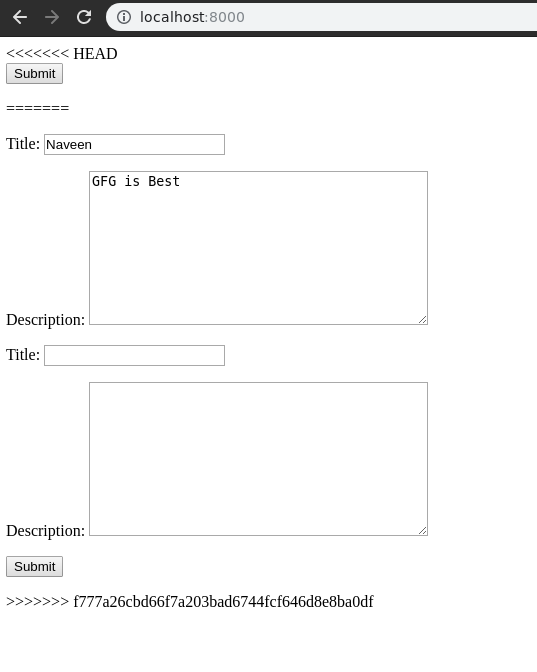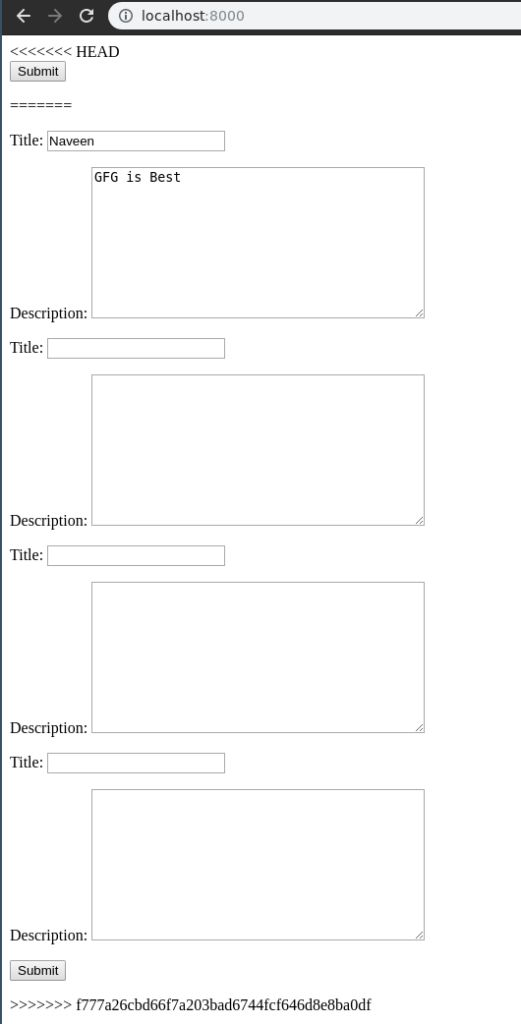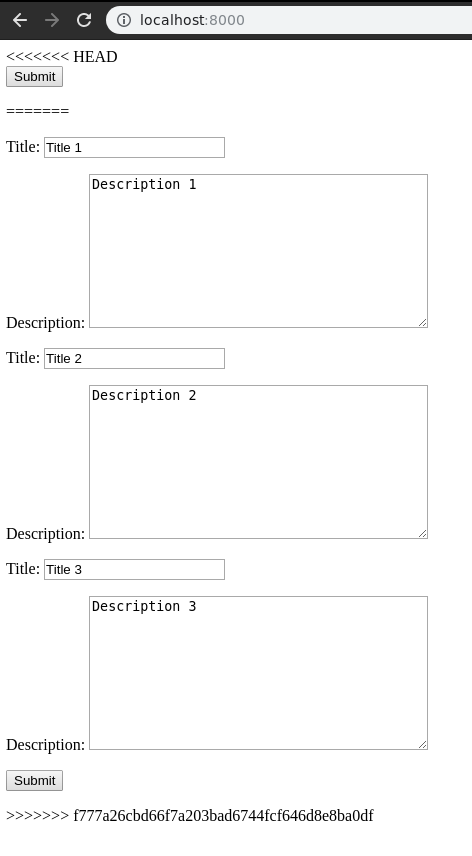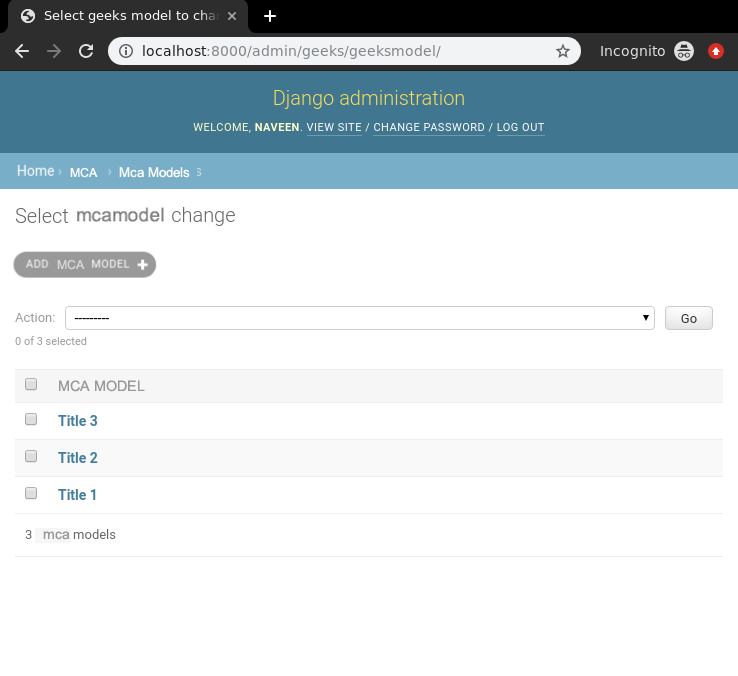Theoretical Paper
- Computer Organization
- Data Structure
- Digital Electronics
- Object Oriented Programming
- Discrete Mathematics
- Graph Theory
- Operating Systems
- Software Engineering
- Computer Graphics
- Database Management System
- Operation Research
- Computer Networking
- Image Processing
- Internet Technologies
- Micro Processor
- E-Commerce & ERP
Practical Paper
Industrial Training
Django ModelFormSets
ModelFormsets in a Django is an advanced way of handling multiple forms created using a model and use them to create model instances. In other words, ModelFormsets are a group of forms in Django. One might want to initialize multiple forms on a single page all of which may involve multiple POST requests, for example
class McatutorialsModel(models.Model):
title = models.CharField(max_length = 200)
description = models.TextField()
Now if one wants to create a modelformset for this model, modelformset_factory needs to be used. A formset is a layer of abstraction to work with multiple forms on the same page. It can be best compared to a data grid.
from django.forms import formset_factory McatutorialsFormSet = modelformset_factory(Mcatutorials)Creating and using Django ModelFormsets
Illustration of Rendering Django ModelFormsets manually using an Example. Consider a project named mcatutorials having an app named mcatutorials.
Refer to the following articles to check how to create a project and an app in Django.
In your mcatutorials app make a new file called models.py where you would be making all your models. To create a Django model you need to use Django Models. Let’s demonstrate how,
In your models.py Enter the following,
# import the standard Django Model
# from built-in library
from django.db import models
# declare a new model with a name "McatutorialModel"
class McatutorialModel(models.Model):
# fields of the model
title = models.CharField(max_length = 200)
description = models.TextField()
# renames the instances of the model
# with their title name
def __str__(self):
return self.title
Let’s explain what exactly is happening, left side denotes the name of the field and to right of it, you define various functionalities of an input field correspondingly. A field’s syntax is denoted as
Syntax :Field_name = models.FieldType(attributes)
Now to create a simple formset of this form, move to views.py and create a formset_view as below.
from django.shortcuts import render
# relative import of forms
from .forms import McatutorialsForm
# importing formset_factory
from django.forms import formset_factory
def formset_view(request):
context ={}
# creating a formset
McatutorialsFormSet = modelformset_factory(McatutorialsForm)
formset = McatutorialsFormSet()
# Add the formset to context dictionary
context['formset']= formset
return render(request, "home.html", context)
To render the formset through HTML, create a html file “home.html”. Now let’s edit templates > home.html
< form method="POST" enctype="multipart/form-data">
{% csrf_token %}
{{ formset.as_p }}
< input type="submit" value="Submit">
< /form>
All set to check if our formset is working or not let’s visit http://localhost:8000/.

Our modelformset is working completely. Let’s learn how to modify this formset to use extra features of this formset.
How to create Multiple forms using Django ModelFormsetsDjango formsets are used to handle multiple instances of a form. One can create multiple forms easily using extra attribute of Django Formsets. In mcatutorials/views.py,
from django.shortcuts import render
# relative import of forms
from .models import McatutorialsModel
# importing formset_factory
from django.forms import modelformset_factory
def modelformset_view(request):
context ={}
# creating a formset and 5 instances of McatutorialsForm
McatutorialsFormSet = modelformset_factory(McatutorialsModel, fields =['title', 'description'], extra = 3)
formset = McatutorialsFormSet()
# Add the formset to context dictionary
context['formset']= formset
return render(request, "home.html", context)
The keyword argument extra makes multiple copies of same form. If one wants to create 5 forms enter extra = 5 and similarly for others. Visit http://localhost:8000/ to check if 5 forms are created.

Handling Multiple forms using Django Formsets
Creating a form is much easier than handling the data entered into those fields at the back end. Let’s try to demonstrate how one can easily use the data of a model formset in a view. When trying to handle formset, Django formsets required one extra argument {{ formset.management_data }}. To know more about Management data, Understanding the ManagementForm.
In templates/home.html,
< form method="POST" enctype="multipart/form-data">
{{ formset.management_data }}
{% csrf_token %}
{{ formset.as_p }}
< input type="submit" value="Submit">
< /form>
Now to check how and what type of data is being rendered edit formset_view to print the data. In mcatutorials/view.py,
from django.shortcuts import render
# relative import of forms
from .forms import McatutorialsForm
# importing formset_factory
from django.forms import formset_factory
def formset_view(request):
context ={}
# creating a formset and 5 instances of McatutorialsForm
McatutorialsFormSet = formset_factory(McatutorialsForm, extra = 3)
formset = McatutorialsFormSet(request.POST or None)
# print formset data if it is valid
if formset.is_valid():
for form in formset:
print(form.cleaned_data)
# Add the formset to context dictionary
context['formset']= formset
return render(request, "home.html", context)
Now let’s try to enter data in the formset through http://localhost:8000/

Hit submit and data will be saved in McatutorialsModel where server is running. One can use this data in any manner conveniently now.


